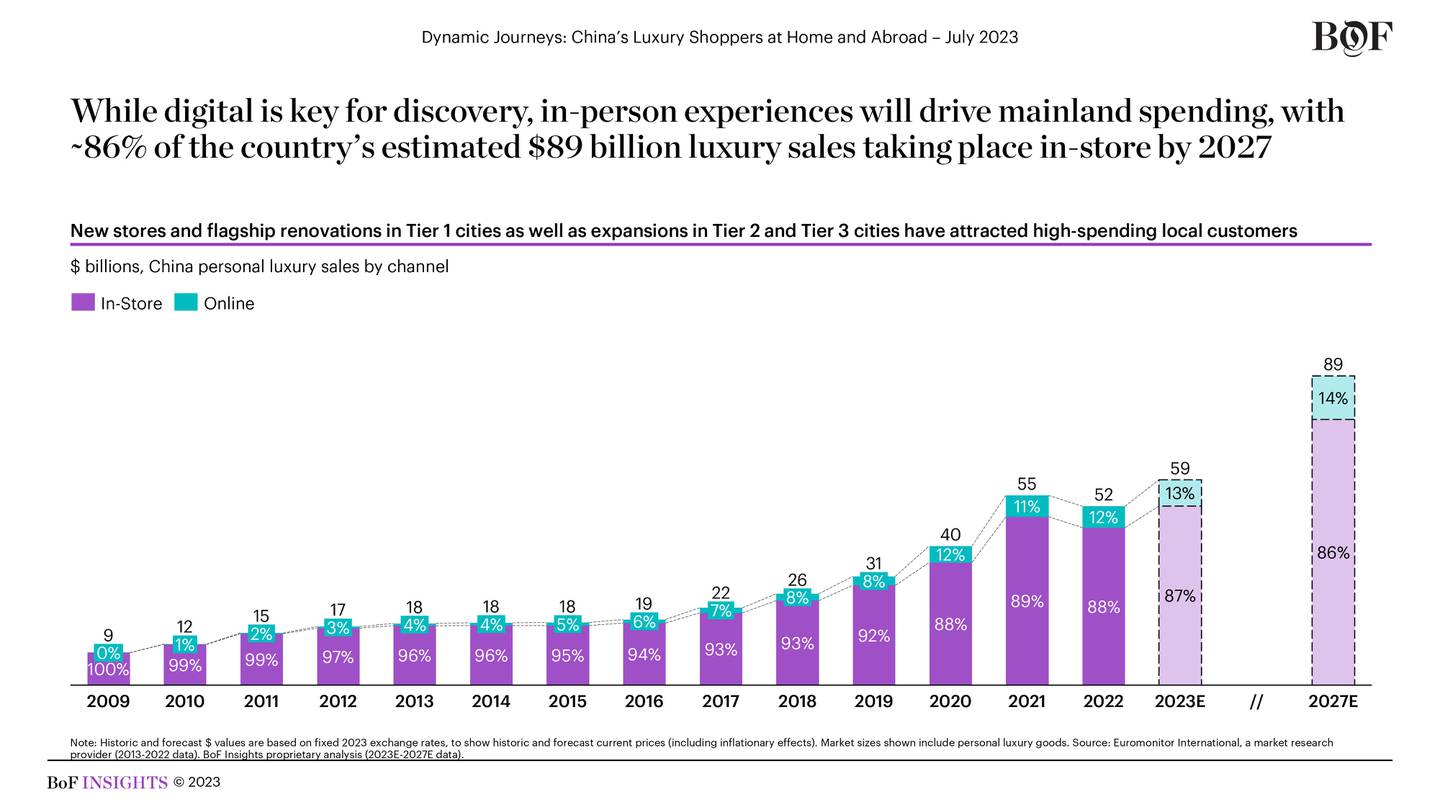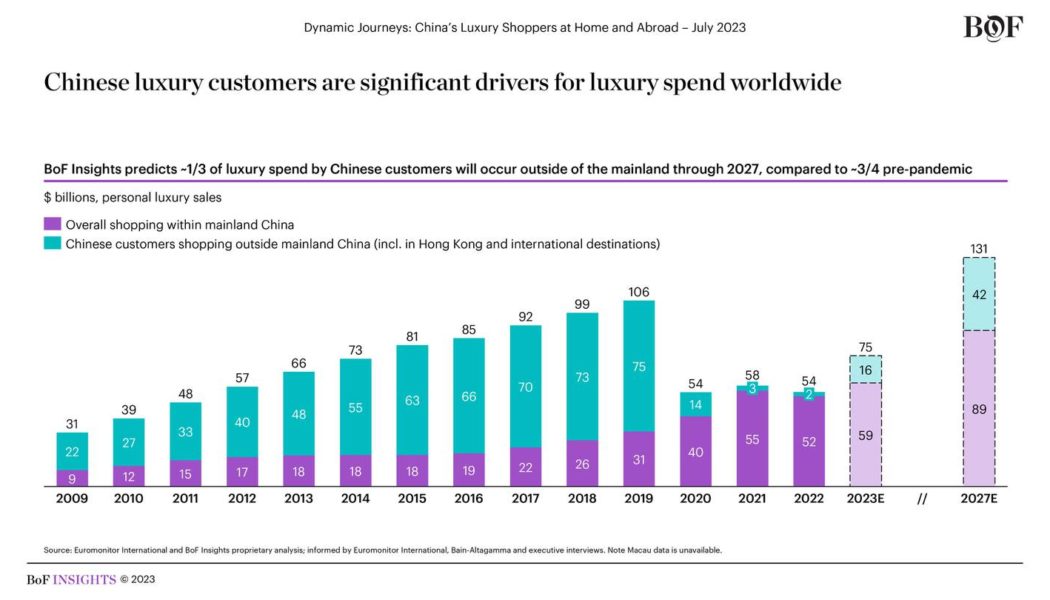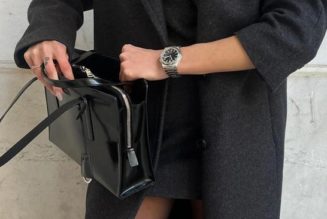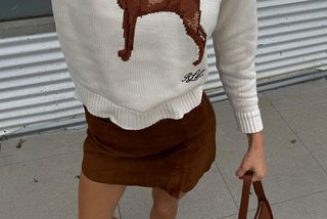For access to the report’s full data and insights to inform your strategy, purchase Dynamic Journeys: China’s Luxury Shoppers at Home and Abroad.
Not so long ago, the most straightforward — and often the least expensive — way for many mainland Chinese consumers to buy the latest fashion or beauty items from their favourite global luxury brands wasn’t to head to their local shopping malls, or even hop online. Instead, they often travelled to Hong Kong, or further afield, visiting London, Paris or New York to shop at flagship stores, where they could feel more assured about the authenticity, price advantages and wider selection of items, cementing their reputations of being among the global luxury industry’s top spenders.
Though the spending continues — forecast to total $75 billion this year — things have changed, according to research for BoF Insights’ latest report, Dynamic Journeys: China’s Luxury Shoppers at Home and Abroad. As Chinese luxury spending continues to recover from the economic impact of China’s zero-Covid policies to surpass pre-pandemic levels and reach $107 billion by 2025, the geographic shift of where that shopping takes place is taking shape — by 2027, BoF Insights expects that two-thirds of the $131 billion of Chinese luxury purchases will occur within mainland China and one-third outside — a balance that marks a complete reversal from pre-pandemic times.
:quality(70)/cloudfront-eu-central-1.images.arcpublishing.com/businessoffashion/2XYEVGRTOJD35OKXNNIWPAIT7E.jpg)
Amid this, Chinese consumers — more and more of whom are part of a burgeoning affluent cohort — are reshaping how and where they shop relative to pre-pandemic years, the BoF Insights report finds. At home, digital is still key for discovery on platforms like WeChat, Douyin and Xiaohongshu, but more and more in-person touchpoints are driving local spending. This will happen as local and foreign brands and retailers not only expand or renovate their stores, but also as they prioritise service, starting with staff — many on-the-ground store associates are already nurturing personal relationships with top customers by, for example, inviting them in-store to purchase limited edition products or attend special, one-off cultural events.

Much of this shopping is taking place amid a widespread embrace of domestic tourism. Three years of closed international borders encouraged the exploration of local destinations, with a long-lasting impact even after borders reopened in early 2023, bolstered by infrastructure improvements to transit, hotels and entertainment options, including luxury shopping. According to proprietary surveys fielded by BoF Insights and fielded by affluent research specialist Altiant in mainland China, almost all surveyed high-net-worth individuals (with investable assets worth a median $1.5 million to $2 million) and more than two-thirds of general customers plan to travel domestically for leisure in the next 12 months. Topping travel wish lists for both cohorts is the tropical island province of Hainan, which is in the midst of a major initiative to become a duty-free luxury shopping destination — attracting global luxury brands, such as Louis Vuitton, Gucci and Dior.
This is not to say international travel is off the table. Nearly all surveyed high-net-worth individuals and about half of general customers have international travel plans in the year ahead. Japan tops the global wish list, with other popular destinations such as the US also expected to benefit from the lifting of restrictions for China’s shoppers to travel without tour groups. However, those who travel abroad will be looking for more than price advantages and tax savings when luxury shopping, according to experts speaking with BoF Insights, who note that culture- and nature-inspired experiences, rather than shopping alone, are key motivations for Chinese travelling abroad.
For global luxury brands and retailers, the impact of these consumer shifts are profound, and both international and domestic strategy must be adapted accordingly. As Iris Chan, partner and head of international client development at Digital Luxury Group, told BoF Insights, “From a customer relationship management perspective, China is . . . at a different level [than where it once was]. Brands must be prepared for customers that have higher expectations than ever. They need to consider that there are more components to the shopping experience [for Chinese luxury customers] than just price.”
Why this BoF Insights report is a must-have:
- Analyses the luxury shopping behaviour of Chinese customers at home and abroad with a deep focus on mainland China and Hong Kong, which together will account for about 20 percent of global luxury sales by 2027
- Assesses critical macro-level trends impacting China’s domestic luxury market, such as government initiatives promoting domestic consumption, a growing affluent consumer base and increasingly attractive local offerings after international border closures due to the Covid-19 pandemic
- Features proprietary research surveying both nationally representative and HNWI Chinese consumers, revealing their shopping journeys from inspiration to purchase; current and future fashion and beauty budgets including local spend compared with spend while travelling abroad; favourite luxury fashion and beauty brands, and the top domestic and international travel destinations planned for the year ahead
- Provides executive perspectives on customer behaviour along with pricing strategies of brands and retailers, and the digital and physical retail landscape in mainland China and Hong Kong compared to the rest of the world
This report is based on research inputs that include:
- A proprietary general consumer survey that is nationally representative of the 18+-year-old, online population in China (N = 1,008)
- An Altiant LuxuryOpinions® survey of affluents and HNWIs (with investable assets worth a median value of approximately $1.5 million to $2 million) conducted on behalf of BoF Insights in China (N = 100)
- 15 interviews with founders, CEOs and other senior executives from luxury brands and retailers, consultancies, and experts from e-commerce companies and third-party data providers
- Market sizing data from Euromonitor International
- Social media sentiment analysis on daigou shopping and domestic and international travel from Quilt.AI
- Brand marketing and Chinese key opinion leader (KOL) performance data from Launchmetrics
- Wholesale transaction data from Joor
- Featured companies include but are not limited to: Bottega Veneta, Burberry, Chanel, Dior, Dolce & Gabbana, Farfetch, Fendi, Gucci, Hermès, JD.com, La Mer, Lane Crawford Joyce Group, Louis Vuitton, Prada, Ralph Lauren, Sisley Paris and Tmall Luxury Pavilion
For access to the report’s full data and insights to inform your strategy, purchase Dynamic Journeys: China’s Luxury Shoppers at Home and Abroad.
:quality(70)/cloudfront-eu-central-1.images.arcpublishing.com/businessoffashion/QMQ25FG2UBAZTAC3VSHPWM2ITE.png)









